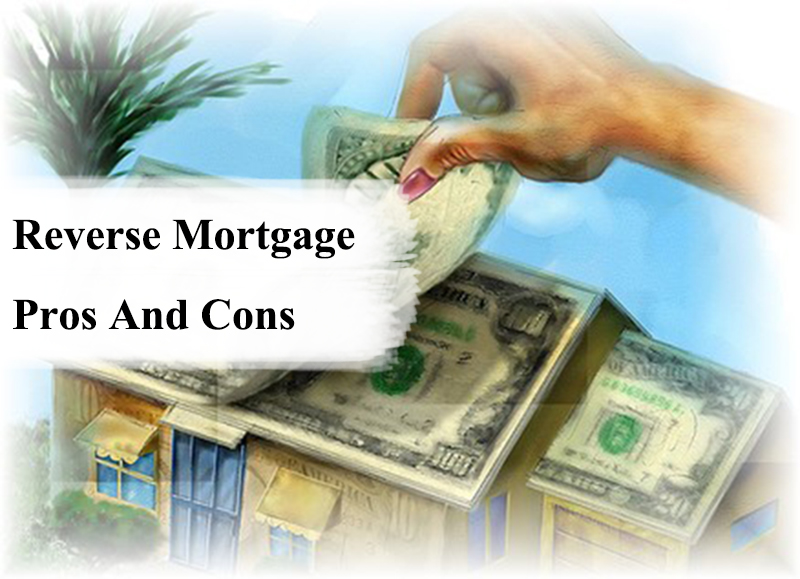If you’re a homeowner who is at least 62 years old and exploring ways to finance retirement, you may be considering a reverse mortgage: a product that allows you to convert your home equity into cash. Whether you are looking for money to pay for a home improvement, cover healthcare expenses or pay off an existing mortgage, a reverse mortgage can provide fixed monthly payments or a line of credit without the need to move or repay a loan every month. While it sounds easy enough, keep in mind that a reverse mortgage is a major financial decision that requires careful consideration and research. To get you started, here’s a quick introduction to the pros and cons of this loan product.
How It Works
You probably purchased your home with a regular or “forward” mortgage, where you make monthly payments to a lender while gradually building up equity in your home. In a reverse mortgage, a lender makes monthly payments to you, gradually purchasing the equity in your property. You continue to hold title to the property, which acts as security for the loan. The loan is repaid when the home is no longer your principal residence, you sell the home or you pass away.
Forward mortgage = Your debt decreases, and your home equity increases.
Reverse mortgage = Your debt increases, and your home equity decreases.
Pros
Reverse mortgages offer many advantages:
- You can often choose how the cash is paid to you: a single lump sum, a regular monthlycash advance, a line of credit where you decide when and how much of your available cash is paid to you, or a combination of these methods.
- Regardless of how the cash is paid out, you normally don’t have to pay anything back as long as you (or any co-owners) live in the home as a principal residence.
- There is no required minimum income to qualify (because you don’t have to make monthly repayments).
- If you receive more payments than your home is worth (i.e., you “outlive” the loan), you will not owe more than the value of the home, according to the Federal Trade Commission.
- Cash advances are typically non-taxable.
- You maintain the title to the home (you remain the owner).
- If you have a federally-insured Home Equity Conversion Mortgage (HECM), you can live in a nursing home for up to 12 months before the loan becomes due.
- Cash advances typically do not affect your Social Security or Medicare benefits.
- After the home is sold and the lender fees are paid, any equity left in the home goes to you or your heirs.
Cons
Reverse mortgages have disadvantages, as well:
- You must be at least 62 to qualify.
- You must go through (and pay for) mandatory mortgage counseling.
- Loan origination fees and closing costs can be expensive (these fees can be rolled in to the loan and financed).
- You may be charged monthly servicing fees during the term of the mortgage.
- Most reverse mortgages are variable interest rate loans tied to short-term indexes.
- Your debt increases over time as interest is added to the loan balance.
- You cannot deduct the interest until the loan is paid off.
- The loan can become due if you fail to pay taxes, homeowner’s insurance or other expenses.
- There are limits on how big a mortgage you can get, and how much you can borrow during the first year.
- Reverse mortgages use up equity in your home, leaving you and your heirs with fewer assets.
In Transition
A recent court ruling required the U.S. Department of Housing and Urban Development (HUD) to ensure that both spouses are listed on a reverse mortgage, even if one is younger than 62 and can’t be an official borrower. This will help future borrowers avoid a situation that has left surviving spouses who had not been listed on a reverse mortgage faced with the task of repaying it or losing their home.
In some cases, couples had not listed a qualified younger spouse on the reverse mortgage so they could borrow more money; older borrowers are able to get larger payments than younger people. Now the loan will have to be based on the age of the younger spouse, whether he/she is listed as a borrower or not. How this change will affect non-borrower spouses whose reverse mortgages predate August 4, 2014, is still unclear.
Your Options
If you are considering a reverse mortgage, shop around and compare your options. You will find more than one type of reverse mortgage on the market, including:
- Single-purpose reverse mortgages, which are offered by some state and municipal government agencies and non-profits;
- Federally-insured reverse mortgages, known as HECMs (Home Equity Conversion Mortgages), backed by HUD; and
- Proprietary reverse mortgages, which are private loans backed by an issuing company.
Government-sponsored mortgages may be offered at more favorable rates and may provide more flexibility in terms. However, for those with more valuable properties, proprietary lenders may provide access to larger loans. Research several loans to identify the best deal and never simply respond to a TV ad or other pitch.
After closing, you have three business days (which include Saturdays, but not Sundays or legal public holidays) to reconsider your decision and cancel the loan, without penalty. You’ll have to notify the lender in writing of your decision: Send your letter by certified mail (ask for a receipt) and keep copies for yourself. The lender has 20 days to return any money you’ve paid up until that point for financing
The Bottom Line
Reverse mortgages may be a good option for people who want to turn equity into cash. Often, candidates are “house-rich and cash-poor,” meaning they have lots of equity in their home, but not enough income coming in. Because of the high upfront costs and loss of equity, many consider reverse mortgages a last resort.
–INVESTOPEDIA
Like this article or found it helpful? Share it!
Follow us on Twitter for more news, tips and inspiration. Become our mate on Facebook and explore our Pinterest boards.


